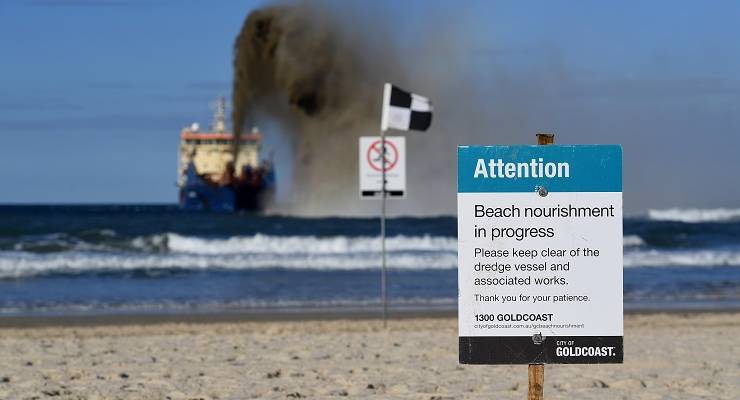
We can’t really sugar-coat it: Australia’s coastline is collapsing. But according to the experts, there are things that can be done to slow the effects of this erosion. Many come with a price.
1. Action on climate change
Ultimately, this is the key going forward; every expert Inq spoke to agreed that the effects of climate change will accelerate coastal erosion in vulnerable spots.
A certain amount of erosion — sometimes a lot — is natural and unavoidable. Indeed, some sites would almost certainly have experienced similar levels of erosion regardless of the current impacts of climate change.
However, climate change brings about rising sea levels — for sandy coastlines, the generally accepted rule is that one metre will be lost for each centimetre of sea level rise, and sea levels could rise by as much as 100 centimetres by the end of the century. It also causes more frequent and extreme storms. In combination, the impact of climate change on erosion will be huge in years to come.
As Zita Sebesvari, Head of Environmental Vulnerability and Ecosystem Services at United Nations University, writes in The Conversation: “How far the oceans rise will depend a great deal on what we do in the next few decades. Whether emissions can be restrained and sharply reduced will mean the difference between manageable disruption and catastrophic inundation.”
Sebesvari goes on to point out that healthy coastal ecosystems — like marshes, mangrove swaps and wetlands — both stabilise coastlines and have a role to play in retaining carbon that would otherwise be released into the atmosphere.
2. Better planning
While substantial emission reduction will eventually slow sea level rise, we still have the issue of what happens to people in erosion hot spots right now. As Victorian Marine and Coastal Council chair Associate Professor Anthony Boxshall told Inq, the best way to avoid losing coastal communities and infrastructure is to “avoid putting things in dumb places that are going to flood”.
Professor Andrew Short of the University of Sydney agrees: “the present problem is local and state governments have allowed development in what we call the coast hazard zone.”
While this is scant consolation for communities such as Seabird or Ledge Point or Stockton — who are all having to entertain the possibility of a “managed retreat” from their homes and businesses — it’s helpful for new developments. There are now erosion-based building restrictions being put in place in WA and Victoria.
Professor Short said that apart from these restrictions on development, state and local governments should introduce a buyback scheme where past development has occurred, much like what has previously been implemented for people who built on floodplains.
Such a scheme would be expensive and would need federal support to occur, Short said.
3. A national strategy
In March 2019, the Western Australian government identified 55 “hotspots” where coastal erosion is expected to cause serious issues within 25 years. In response to this, WA Premier Mark McGowan called for “a national co-ordinated response”.
“I want to have a mature conversation with the Commonwealth about how we jointly address this issue that’s going to dramatically impact communities and infrastructure for decades, if not centuries, to come.”
Of course, part of what McGowan has in mind is help with the potentially huge costs of management (in WA, estimated at $110 million over the next five years). But he’s not alone in thinking a more comprehensive plan is necessary.
The scientists we spoke to said that, until now, responses have too often been reactive, stop gap and uncoordinated; they look at individual beaches, rather than recognising a coastline as one system. It is, as University of Western Australia senior lecturer Dr Mick O’Leary put it, a long “river of sand”.
4. Avoiding man-made sea structures
Coastal infrastructure is generally indicative of this kind of short-term thinking. Seawalls can be effective in one location, but they often just move the problem somewhere else.
Short told Inq seawalls tend to protect the interests of private property owners on the coast at the expense of the beach.
The New South Wales coastal management plan (which also wants federal help) acknowledges this. “Unless seawalls are constructed in coordination with all affected landowners, you can actually cause a situation where erosion is exacerbated at either end of the seawall, damaging adjacent properties. There needs to be coordination of effort,” NSW Planning Minister Rob Stokes said through a spokesperson.
At the same time, coastal structures — such as the breakwaters and a deep water channel in Stockton — just make erosion worse, disrupting wave patterns and preventing beaches from receiving new sand.
5. Sand barriers
Sand replenishment — as is used on the Gold Coast, where sand is dredged and pumped off shore by barges — can be effective, but it’s also very expensive and has to be undertaken again and again.
It’s also been known to disturb local sealife. Onshore, sand dunes can slow the retreat of the coast; however man-made dunes and transplanted vegetation can disrupt local habitats and food chains. Natural dunes and vegetation are more durable, but slow forming.








How absurd that humanity, even more so, Australians, presume to hold-back Tides? For that is at the genesis of each INQ article? Humanity cannot, on the scale required, succeed.
Unlike ‘Emissions’ whereby maximum effort may yet be possible to stabilize, reduce. Oceanography ‘drivers’ ie chemistry, cyclonic, ice caps et al now unstoppable for and by present, immediate, future generations?
How absurd, on a world scale, that an Australian dollar, be it logical, hold back 360* of tidal energy now released as a consequence of Climate denial? Far more logical to invest in progressive forward planning for safeguarding, relocating, of national infrastructure, population. Forget sand, sea walls. At best, expensive and short term.
As Australian Govt(s) scientific and climate documents identified decades ago (withheld from Public scrutiny); 85% of population resides within 50 kms of coast. Virtually all national Infrastructure so too. Today’s Crikey INQ articles should be incorporated into both Primary/Secondary curriculums to assist younger generations comprehend what our generation is passing on? Equally, as ‘Fire’ has now forced Govt(s) hand; the impacts of Oceans worldwide (and their allies as above) now form the greater challenge of all, for Humanity.
Thus far, despite all efforts as far back as Lord Nicholas Stern’s early 70’s economic appraisal of impending Climate threat; world governance has failed their peoples.
Postscript: Tidal inundation, infiltration of coastal belt (not confined to eastern seaboard) means.
a) loss of arable land
b) loss of infrastructure
c) loss of habitat. All land creatures, us included
Most of all . . . Severe reduction of access/storage to fresh water.
Ip so facto: Does one believe if the Nation loses even a small percentage of the 50 kms coastal belt around the entire Continent . . everything remains hunky dooray for future generations? Australia needs serious attention be given to National Leadership as first priority response to accommodating imminent climate threat.
An ENTIRE edition of Crikey given to a SINGLE topic illustrates (1) the stupidity of the editorial staff and their ignorance thereof vis a vis the topic and in conjunction to the simplemindedness of the writers.
Following on from greybul (above) it was damed fortunate for NZ and Oz that the White Island incident did not create a major earth quake accompanied with a major tsunami that might have been felt in Penrith.
The (so called) assets of Oz and NZ exist in the Torrens System; there is barely a cent of venture capital. The two countries would be rendered banana states overnight if such were to occur.
The problems Australia is facing, be they drought, floods, fires, erosion, dust storms are all exacerbated by climate change.
The affects can only be minimised by taking immediate and meaningful action.
How do we get the society at large to accept that?
It is obvious that the alleged government under the dubious leadership of our alleged PM will not act.
Therefore, the people must be convinced of the danger and the need for action.
The people will demand, the politicians will follow.
Lest we have no coastline, no river system, no Country.
“Lest we have no coastline, no river system . . . .” Regretfully Rayh, unlike fire, drought etc, ocean tidal inundation is the big one. Already locked-in. As are more intense weather events exacerbating oceanic impacts.
Consequentially, only ‘open’ challenge is to prepare. That means:
1 Resolve decades long diversional private property legal challenge/compensation claims.
2 Prioritize provision of new potable water storage supplementation ie reservoirs.
3 Protect against salinity intrusion into river and where practical flood plains.
4 Progressively relocate essential infrastructure ie roads, bridges, industrial facilities etc
Primary challenge, as you have identified, is to address National Leadership. How? No idea. Reject short term solutions. Recent landscape incineration illustrates how difficult that is? One thing for sure . . . much requires “pushing up hill” and WE all know, how easy it is to fritter away decades avoiding addressing / resolving / agreeing / disagreeing . . . Political Leadership does not care about future generations left without solutions and not of their making. Bastards!